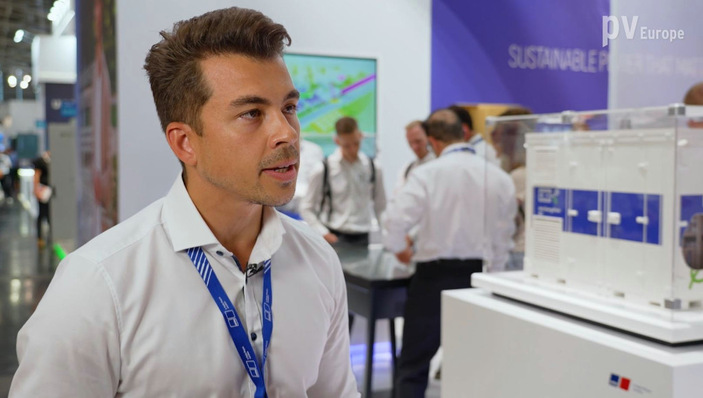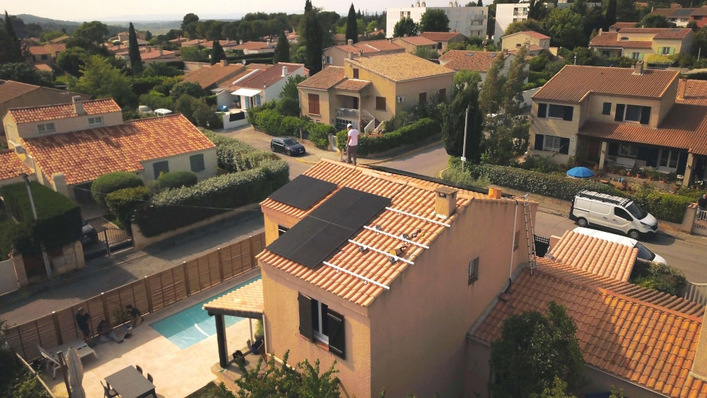Energy storage systems are a young technology for which the large-scale manufacture and installation with customers is only picking up steam this year. Nevertheless, many installing companies and technicians have already been intensely involved with solar battery storage. Because customers are increasingly wanting to be independent and are asking for storage batteries for PV.
One of the key suppliers is Sonnen from Wildpoldsried in the Allgäu. The company has been committed to lithium batteries from the start. This year, they will sell far more than 10,000 systems – and distribution to the US and Australia is also gaining ground. But what cannot be argued away for PV also is true for storage units: The quality of installation is crucial to the reliability of the storage system – and thus to its efficiency and profitability.
Battery systems simplified significantly
This is also clear to Hermann Schweizer, CTO and managing director at Sonnen. This manufacturer has been focussing on the qualifications of their installing company partners. “Mistakes used to happen much more in the past,” Hermann Schweizer reports. “In the meantime, we have simplified our systems significantly. Among others, because our battery modules can now be connected through plug connectors. Problems where the technician needs to contact our support hotline only come up in about one percent of installations.”
Sonnen separately deliver their batteries to the building site, according to the desired storage capacity. “All the technician does is put them into the system and hook up the poles and data connections,” the expert explains. “Plug connectors make mistakes almost impossible.”
In the last four years, the company has trained about 2,500 technicians as certified Sonnen partners. “We also offer this opportunity in the UK, Italy, the US and Australia,” Schweizer says.
Installation via an app
He knows that people in the different countries tick differently. Training schemes and levels of qualification vary from market to market. “In our latest version we offer an installation assistant that takes the technicians through the installation and activation procedures step by step,” he says. “In the US, we use the smartphone app Field Log which guides the technician and also supports him in the activation documentation, all the way to the final report.”
Sonnen exclusively markets its storage systems directly to installing companies without going through wholesalers. Here it is important to keep the sales partners, who install the systems with the customers, up to date: “In a one-day training session, we tell our installation partners about all the issues that the technician might be faced with from our customers. It is about understanding the full potential of the systems. Of course, we also train them in the technical side of setting up and possible challenges during activation. By closely staying in touch with the installing companies and technicians, any feedback concerning our systems comes back to us very quickly.”
Complete systems at an advantage
Sonnen offers complete systems rather than individual components that would have to be connected by the technician. “We as a system supplier take over more responsibilities than the installing company or technician, who just hooks the system up at the customer’s,” Hermann Schweizer explains. “In order to exclude mistakes, we try to keep the variety in our systems to a minimum, at least as far as installation goes. All variants are based on one system that the technician is familiar with.”
Connecting the battery system to the grid is usually no problem. Merely positioning and installing the metre can cause difficulties. It is all about arranging the metre within the house installation in such a way that it exactly records both the energy consumed by the customer and the electricity produced by the solar array.
The correct IP address
The solar electricity can be recorded fairly easily through the inverter of the PV installation. Recording the consumption can be more complicated if the house installation is not structured properly or if there is an adjacent building with its own separate metre.
One other source of errors is the connection of the storage system to the Internet via a data link. “Usually the technicians make a physical connection, but sometimes the storage units cannot properly be accessed within the customer’s network,” the expert advises. “It is a matter of the right IP addresses, of passwords or access; in commercial systems also of firewalls and admin by the company’s IT department.”
Getting to grips with the technology
Fronius in Austria also put a strong focus on service and information. They are offering two battery systems: their own Energy Package and soon also Tesla’s Powerwall. “Hooking up a storage unit is not as easy as installing a normal PV installation,” Gerald Hotz, head of sales at Fronius Solar Energy in Austria, says. “The majority of installing companies are able to correctly plan the output of a PV installation and properly install the inverter. For battery storage, greater know-how is needed. Without training, setting up solar storage at a decent quality and within a decent timeframe can be difficult.”
The way he sees it, most installing companies and technicians have gotten to grips with energy storage technology. “Most times, the installation works out well and without requiring a call to our hotline. Once someone has installed a storage unit for the first time, mistakes are rare, generally speaking,” he remarks. “Furthermore, our training sessions were way overbooked; we even offered additional dates. Now, after one year’s experience, mistakes during installation have become very infrequent. The number of calls to our hotline has come down significantly.”
He points out that the battery’s control unit has to be connected to the Internet under any circumstances. “If the hybrid manager which is part of the Fronius Symo Hybrid inverter is not connected to the Internet, we are unable to analyse any faults through the online portal Fronius Solar.web,” he explains. “The Fronius Smart Meter, our electronic metre as well as the hybrid manager and the Fronius Solar Battery all need to be wired and configured for data beforehand. Only then can we make use of the online visualisation.”
Few faults with the Tesla energy storage unit
The communication link consists of three wires and it causes very few issues for technicians. To exclude possible errors, connecting the Tesla battery happens similarly to the Fronius Energy Package. “The Tesla Powerwall is connected as a single compact unit. There is very little difference to previous storage systems. Even the inverter is identical.”
If the customer wants emergency power supply capability, a number of adaptations need to be made in the control cabinet, depending on the grid operator’s requirements. Prior to installation, it is highly advisable to verify the circuit diagram with the grid operator. That way there are no nasty surprises or unanswered questions.
Always have all data to hand
Nicole Windischbauer is very familiar with the issues that can come up for the installing companies and technicians. She is a member of the technical support team at Fronius. She has the following pointers: “It is often the little things that get forgotten. We have already found some potential faults during the pilot run and have then made improvements to the Fronius Energy Package. For example, we ship the Fronius Solar Battery partially wired, whereby we have eliminated the main sources for errors. If there still is a problem with faulty wiring, the technicians call our hotline and we solve the problem together.”
She remarks that it has happened in the heat of the fray that the polarity gets switched while connecting the them. “But that sort of thing happens very rarely,” she confirms. “We always recommend that technicians take part in one of our trainings.”
In Fronius’ trainings, the most common mistakes are pointed out, so that technicians are prepared for them. For instance, they are reminded to always check that important data concerning the customer’s Internet access are at hand. “This starts with the password for the router. Prior to activation, the technician needs to make sure he has access to that.” (HS/HCN)
Read more about energy storage
Video: The great vision of Fronius: 24 hours of sun
Video: The installation of Tesvolt’s commercial lithium ion system is as easy as a box
Video: A match in Kropstädt: How to make a commercial energy storage system
Stay informed, get our free newsletter twice a week, register here







